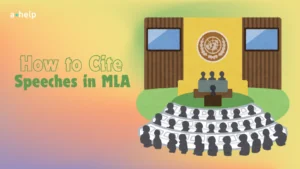The significance of citation in academic writing serves as a testament to the credibility of research, assuring due credit is given to original authors. In the text below, we explore the nuances of citing interviews, looking predominantly at the APA, MLA, and Chicago styles with a focus on creating full interview citations, in-text citations, and bibliography entries.

✅ AI Essay Writer ✅ AI Detector ✅ Plagchecker ✅ Paraphraser
✅ Summarizer ✅ Citation Generator
Citation, a multifaceted practice, serves the dual purpose of crediting authors and facilitating source traceability. Plenty of citation styles arises from the diverse preferences and requirements of academic disciplines and publishers. Each style caters to specific academic disciplines and preferences, providing a diverse range of options for researchers and scholars.
| STYLE | FEATURES |
| APA | In-text citation, author-date format, emphasis on publication year, alphabetical reference list |
| MLA | In-text citation, author-page format, emphasis on page numbers, Works Cited page |
| Chicago | Footnotes or endnotes, bibliography, two documentation systems (notes and bibliography, author-date) |
| Harvard | In-text citation, author-date format, emphasis on publication year, reference list |
| IEEE | Numeric citation, bracketed numbers, references in numerical order, emphasis on publication year |
| Vancouver | Numeric citation, superscript numbers, list of references in numerical order |
| Turabian | Similar to Chicago style, designed for student research papers, notes and bibliography system |
| ASA | In-text citation, author-date format, emphasis on publication year, reference list |
Why MLA, APA, and Chicago?
Understanding specific citation styles is necessary in academic writing. Among the commonly embraced styles, three stand out: MLA, APA, and Chicago. These styles play a significant role in shaping scholarly communication, which is why this guide focuses on them.
These three styles have become fundamental in academic institutions globally. MLA, known for its emphasis on literature and the humanities, is often used in language, literature, and cultural studies. APA, with its structured approach, is widely used in the social sciences, psychology, and education. Meanwhile, Chicago style, offering both notes and bibliography or author-date systems, is a versatile choice across disciplines.
In education, adherence to specific citation is a skill that aids effective communication and showcases a researcher’s commitment to academic integrity. These styles provide a consistent framework for citing sources, allowing researchers to build on the knowledge of others while giving due credit. Mastering these styles will help you in contributing to academic conversations in a clear and organized manner.
How to Cite an Interview in APA
In the APA style, citing an interview follows a precise structure. The interviewer’s name, publication date, interview title, and source details play crucial roles. The in-text citation includes the interviewer’s last name and the publication year, ensuring clarity when quoting interviewee’s words.
Bibliography Entry

In-Text Citation

Citing an Interview in MLA
The MLA style adopts a distinctive approach to citing interviews. The interviewee takes precedence in the Works Cited entry, with the interview title, interviewer’s name, newspaper name, and publication details following suit (Ishiguro). In-text citations reference the interviewee’s last name.
Bibliography Entry

In-Text Citation

How an Interview is Cited in Chicago
Chicago style offers flexibility with two documentation systems. In the notes and bibliography system, the interviewee’s name, interview title, interviewer’s name, newspaper name, publication details, and URL comprise a proper citation. The author-date system condenses this information within the text.
Bibliography Entry

Footnote

Conclusion
In academia, the art of citation remains a timeless practice. As we learn about the complexities of APA, MLA, and Chicago styles for citing interviews, it becomes evident that precision and attention to detail are paramount. Understanding the unique features of each style and avoiding common pitfalls, students and researchers can ensure their work stands as a proof of scholarly rigor and integrity.
FAQ
Follow us on Reddit for more insights and updates.





Comments (0)
Welcome to A*Help comments!
We’re all about debate and discussion at A*Help.
We value the diverse opinions of users, so you may find points of view that you don’t agree with. And that’s cool. However, there are certain things we’re not OK with: attempts to manipulate our data in any way, for example, or the posting of discriminative, offensive, hateful, or disparaging material.